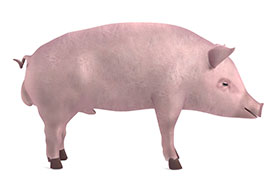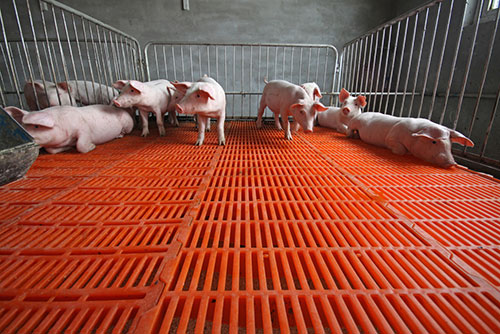



Moving Towards Non-Castration: What are the Alternatives?
As Europe moves towards an outright ban on castration in 2018, researchers are working hard to find alternatives. One alternative is immunocastration, a non-hormone vaccination widely used in Brazil, Belgium and Australia. Another is the production of entire males, which with proper management has been shown to be a viable alternative. Concerns about loss of export markets, however, still have some producers worried, writes Melanie Epp for ThePigSite. In 2010, the European Union, along with pig producers, slaughterhouses, retailers and NGOs, agreed to an outright ban on pig castration beginning in 2018. In most countries, progress has been slow, though.
In 2010, the European Union, along with pig producers, slaughterhouses, retailers and NGOs, agreed to an outright ban on pig castration beginning in 2018. In most countries, progress has been slow, though.
“We really have to practice what we preach,” says Sharon Dijksma, Minister for Agriculture in the Netherlands. “We already decided years ago to stop castration, and it's still not happening.”
As Dijksma sees it one of the big problems is that non-castration raises overall costs for the producer. When they compete with those who don’t have their same goals, they’re not competing on a level playing field.
“There is no argument in the Netherlands about the benefits of producing meat on a higher animal welfare level, but there is discussion in the Netherlands when we see that farmers from other countries do not use the same high standards and come into our markets and compete on a level that we cannot,” she says.
The costs that come along with higher animal welfare standards wouldn’t be a problem if consumers were willing to pay. Although consumers say they're interested in animal welfare, when they’re buying meat their actions prove different. “When they're in the supermarkets, they're not paying with their hearts, but with their minds,” says Dijksma. “And that's also part of the problem.”
The pork industry in the Netherlands agreed to tackle the non-castration goal immediately and has been working on it for years now. Thanks to improved hygiene and careful selection of breeding animals, the number of animals with boar taint in the Netherlands has fallen in recent years, says Dijksma. “But it still occurs in three to five percent of slaughtered pigs,” she says.
As a result, two-thirds of piglets raised in the Netherlands are no longer castrated. It is an outcome that Dijksma is pleased with. But, she says, a higher percentage is out of the question since the Netherlands can’t find more buyers for un-castrated animals. Even though they’ve had a boar taint detection process in place for years, there’s still concern about boar taint. Regardless, she believes that fear of boar taint is not an acceptable reason for castrating pigs.
Alternatives to castration
According to the experts, there are two possible alternatives to castration: immunocastration and the production of entire males. Both methods have been researched for their efficacy, as well as for their acceptance by consumers.
“I know there are concerns about consumer acceptance, but it's already being used in Belgium, it's widely used in Australia and Brazil,” says Peter Stevenson, Chief Policy Advisor of Compassion in World Farming, UK. “It should be possible to explain to consumers that this is not a hormone, and that it has no adverse impact on human health, but huge benefits for pigs in avoiding surgical castration.”
While Stevenson admits that rearing entire pigs is not easy, he says aggression and boar taint can be avoided through a variety of techniques, such as selective breeding, modified feed composition, stress reduction, and cleanliness.
In order to collect data on feed conversion, growth, stress levels and animal welfare, Dr. Frank Tuyttens and Dr. Marijke Aluwé conducted practical trials on non-castrated pigs. Both work as animal husbandry specialists at the Instituut voor Landbouw en Visserijonderzoek (ILVO) in the Netherlands. They found that immunocastrates and entire males had a better gain-to-feed ratio when compared with pigs that were castrated with or without pain control. Lean meat percentage was higher for entire males compared with the barrows, and intermediate for immunocastrated males. Carcass yield was the lowest for immunocastrated males.
While boar taint was completely eliminated in immunocastrated males, it was still prevalent in three percent of entire males on average. Treatment performance and the level of boar taint varied in entire male production, says Aluwé, which is why she recommends pre-testing alternatives first. Pre-testing will allow farmers to make well-considered choices for best practical and profitable alternatives on their farm, she says.
Others have done more in-depth research on the rearing of entire males. For instance, Ge Backus, a member of Steering Committee Boars 2018, was part of a Dutch team that conducted a five-year research project on the subject. During the course of the project, researchers found that crowded housing conditions are associated with a higher probability of boar taint, particularly in pens containing more than 30 animals.

“Preventative measures are effective, though,” he says. “Clean animals and clean floors, wider gaps between the slats and good quality floors are associated with lower boar taint prevalence levels.”
However, even if everything is done correctly boar taint will still occur, says Backus. Currently, boar taint is found in some 3–5 percent of carcasses. There is hope, however, that this can be reduced significantly through genetics in the near future.
A second alternative to castration is immunocastration. Currently, Zoetis makes a vaccination called Improvac, which was first discovered and marketed in Australia where pork producers no longer castrate pigs. Contrary to popular belief, the vaccination is not a hormone. Rather, its active ingredient is an antibody that delays puberty in the boar until after the time of slaughter. The vaccination requires two injections for complete effectiveness. Depending on the needs of the client and their preference for fatter or leaner meat, vaccination schedules can be amended.
Unfortunately, Improvac’s top markets are in countries outside of the European Union, in Canada, the U.S. and Brazil, where 51 percent of pigs are vaccinated. Improvac was launched in Europe in 2009, but uptake has been incredibly slow. Farmers, says Niels Wuyts, Director of Veterinary Operations, Improvac, Zoetis, are concerned about consumer and retailer acceptance and losing access to international markets. He hopes education will change those attitudes in the near future.
According to research conducted at Ghent University in Belgium, consumer acceptance shouldn’t be a problem. Using a web-based questionnaire among 225 Flemish consumers, Dr. Filiep Vanhonacker, research assistant at the university, evaluated awareness of piglet castration and attitudes towards immunocastration.
While only 40 percent were aware of the routine practice of castrating piglets, once educated, sixty percent had a general appreciation for immunocastration as opposed to surgical castration, says Vanhonacker.
“Informing consumers about the potential benefits and/or risks from immunocastration did not tend to have much effect in terms of altering their attitudes,” says Vanhonacker.
While immunocastration did not emerge as a problem in terms of consumer acceptance, Vanhonacker was careful to note that special attention should be paid to consumers’ perception of pricing, food safety and the taste of the meat from immunocastrated pigs.
July 2015








